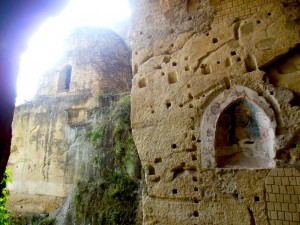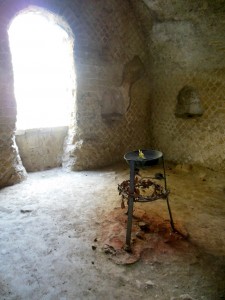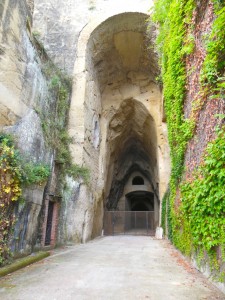Traveling to Naples from the Roman resort of Baiae one day, the Stoic philosopher Seneca decided to go by land instead of by sea. His chosen inland route included a famous tunnel built in Augustan times, the Crypta Neapolitana. But the claustrophobic and gloomy tunnel turned out to be not much better than a sea voyage. Afterwards Seneca wrote one of his famous ‘Letters to Lucilius’ describing his journey using terminology from the races and arena.
When it was necessary for me to return from Baiae to Naples, I convinced myself there might be a storm. Not wanting to endure a sea voyage again, I went by land. But the entire journey was so wet that I may as well have taken a voyage anyway. All the misfortunes of an athlete fell on me that day in the Naples Tunnel from the drenching* to the dusting*. No cramped starting gate at the races is longer than that tunnel, no torches gloomier than those that enabled us to see not through the darkness but rather the darkness itself. Had the place any other light sources it would still be clouded by dust which even in the open air is heavy and annoying. How much more so in that tunnel where it swirls back on itself. Shut up without any ventilation, it blows into the faces of those who stir it up. In this way we simultaneously endured two opposing inconveniences: on the same road, on the same day we battled both mud and dust. Letter to Lucilius LVII.1-2
The claustrophobic darkness of the tunnel plunged the philosopher into morbid musing on the nature of death and the soul (you can read his thoughts here) until the first glimpse of daylight restored him to his usual stoic cheerfulness and he claimed he was never actually afraid.
You can still see both ends of this tunnel – though not the middle, it has collapsed – in Naples today. In fact this tunnel was in constant use up until about a century ago, connecting Naples and Pozzuoli. The eastern (Neapolitan) entrance is found near the so-called Tomb of Virgil in the Parco Vergiliano a Piedgrotta. Located near Mergellina train station (only a half hour’s walk from Castel dell’Ovo) this Parco Vergiliano with an e is not to be confused with the Parco Virgiliano with an i four miles southwest near the little island of Nisida with its manmade causeway. In fact, the smaller park with Seneca’s Tunnel and Virgil’s Tomb was only recently marked on Google maps. To find it, search for Church of the Madonna of Piedigrotta and zoom in a few hundred feet west to where the road enters a modern tunnel. On the left you will see the entrance to the site. Or type in key words Parco Vergiliano a Piedigrotta.
 I was lucky enough to visit the Parco Vergiliano last September with Andante Travels. It is a cool green oasis in this Naples suburb, planted with herbs mentioned in the works of Virgil, all beautifully labelled with tile plaques giving descriptions and the Latin names. A dramatic cliff of famous yellow tufa is cloaked in ivy and dripping with vines. This soft rock is perfect for tombs and tunnels, which the Neapolitans call galleria. The biggest of these is the dramatic Crypta Neapolitana – Seneca’s tunnel. Next to it is Virgil’s so-called tomb. Nearby is another tomb, that of Giacomo Leopardi (1798-1837) the hunchback poet who was a great worshipper of Virgil.
I was lucky enough to visit the Parco Vergiliano last September with Andante Travels. It is a cool green oasis in this Naples suburb, planted with herbs mentioned in the works of Virgil, all beautifully labelled with tile plaques giving descriptions and the Latin names. A dramatic cliff of famous yellow tufa is cloaked in ivy and dripping with vines. This soft rock is perfect for tombs and tunnels, which the Neapolitans call galleria. The biggest of these is the dramatic Crypta Neapolitana – Seneca’s tunnel. Next to it is Virgil’s so-called tomb. Nearby is another tomb, that of Giacomo Leopardi (1798-1837) the hunchback poet who was a great worshipper of Virgil.
Undaunted by the background noise of the Mergellina train and police sirens, our guide Richard Wallace read us Tennyson’s Ode to Virgil. Then he told us there is another possible tomb to Virgil on a higher level.
Climbing the brick stairs with the aid of a sturdy wooden handrail you will find a Roman aqueduct that ran above Seneca’s tunnel. You will get a good look at a niche with Madonna and Child carved into the entrance of the tunnel. Then, right on top is the second tomb that also might be Virgil’s, but probably isn’t. This atmospheric freestanding cylindrical tomb is of the columbarium type with niches for ash-filled urns. Someone has left a convenient tripod where you can burn fragrant bay leaves in memory of the great poet.
 Although Virgil’s real burial place is probably lost in antiquity, he wasn’t forgotten. In fact, his fame grew and in the Bay of Naples he gradually came to be thought of as a great magician. According to legend he placed a magic egg somewhere in the eponymous Castel dell’Ovo. As long as the egg remains, the castle will stand strong. The clever poet invented a magic fly to keep away all other flies. He foretold the birth of Christ in his famous “Messianic Eclogue” and became Dante’s guide in the Inferno.
Although Virgil’s real burial place is probably lost in antiquity, he wasn’t forgotten. In fact, his fame grew and in the Bay of Naples he gradually came to be thought of as a great magician. According to legend he placed a magic egg somewhere in the eponymous Castel dell’Ovo. As long as the egg remains, the castle will stand strong. The clever poet invented a magic fly to keep away all other flies. He foretold the birth of Christ in his famous “Messianic Eclogue” and became Dante’s guide in the Inferno.
Best of all, Virgil created the Crypta Neapolitana in one hour, merely by looking at it intently, (not unlike Superman with his laser vision.)
According to one eighteenth century travel writer, the “grosso popolo” of Naples revered Virgil more for his creation of this tunnel than for the Aeneid. So it is fitting that you will find Virgil’s Tunnel near one or both of his possible tombs.
Caroline Lawrence is working on a new series of contemporary kids’ history-mystery books set in Naples, inspired by two recent trips to Italy with Andante Travels.
*For more on these technical terms, see Lacus Curtius

